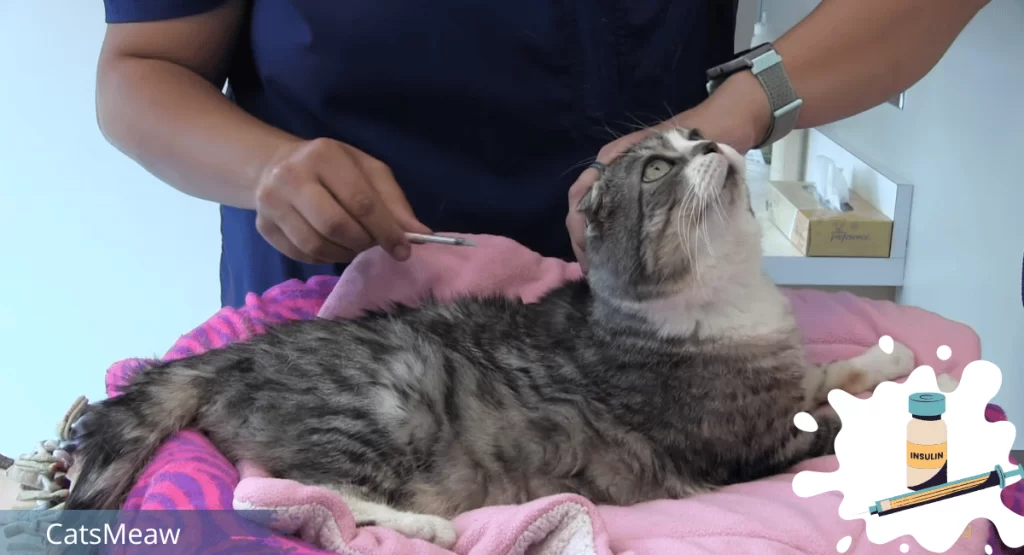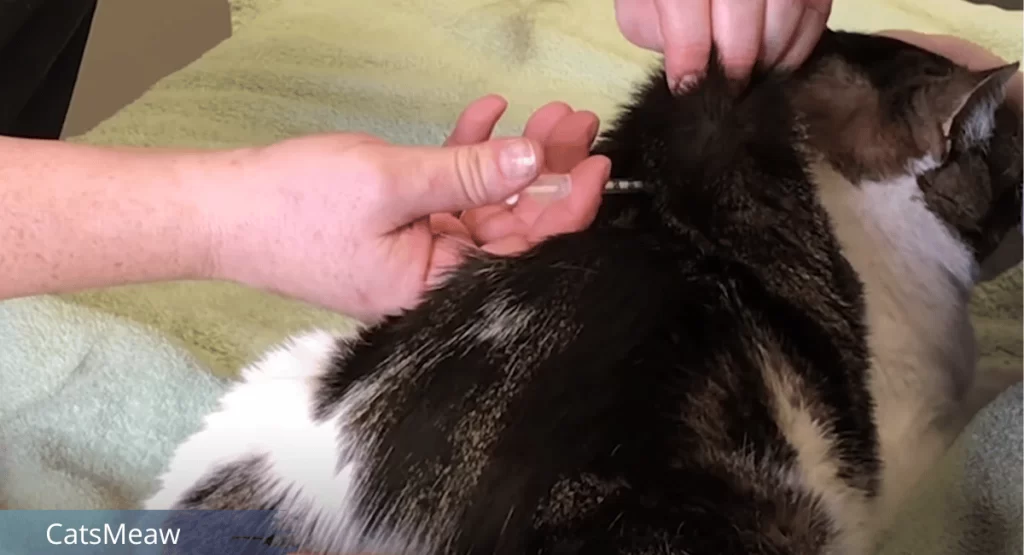Diabetes is a chronic metabolic disorder that affects cats, just as it does humans. It occurs when the pancreas fails to produce enough insulin or when the body becomes resistant to the insulin produced. Insulin is essential for regulating blood sugar levels in the body. When talking about diabetes in cats, their blood sugar levels become elevated, leading to various health complications if left untreated.

Table of Contents
Common symptoms of diabetes in cats
Recognizing the symptoms of diabetes in cats is crucial for early detection and effective management. Here are some common signs to pay attention:
- Increased thirst and urination: If you notice that your cat is drinking more water than usual and having more frequent trips to the litter box, it could be a sign of diabetes.
- Weight loss: Despite a good appetite, cats with diabetes often experience weight loss due to the body’s inability to utilize glucose properly.
- Increased hunger: Cats with diabetes may exhibit an increased appetite as their body struggles to utilize glucose effectively.
- Lethargy: Diabetes can make cats feel weak and lethargic, leading to decreased activity levels and a lack of interest in play.
- Urinary tract infections: Diabetic cats are more prone to developing urinary tract infections, which can cause discomfort and pain.
If you notice any of these symptoms in your cat, it is essential to consult your veterinarian for a proper diagnosis.
Diagnosing diabetes in cats
Diagnosing diabetes in cats requires a series of tests conducted by a veterinarian. These tests may include:
- Physical examination: Your veterinarian will conduct a thorough physical examination of your cat, checking for any signs of weight loss, dehydration, or other symptoms of diabetes.
- Blood and urine tests: Blood and urine samples will be collected to measure the blood sugar levels and assess the overall health of your cat. Elevated blood sugar levels and the presence of glucose in the urine are indicative of diabetes.
- Glycosylated hemoglobin test: This test provides a more accurate picture of your cat’s blood sugar control over the past few weeks, allowing the veterinarian to determine the severity of the diabetes.
Our pick: The Best Cat Health Supplies
Once a diagnosis is confirmed, your veterinarian will discuss the best treatment options for your diabetic cat.
Types of diabetes in cats
There are two types of diabetes that can affect the cats:
- Type 1 diabetes: This type occurs when the pancreas fails to produce enough insulin. It is the most common form of diabetes in cats and requires insulin injections for proper management.
- Type 2 diabetes: In this type, the body becomes resistant to insulin, leading to elevated blood sugar levels. Type 2 diabetes in cats can often be managed through lifestyle changes, such as diet and exercise, but may require insulin therapy in some cases.
Understanding the type of diabetes your cat has is crucial for determining the most effective treatment approach.
Related: Best Guide to Trimming Your Cat’s Nails
Risk factors for diabetes in cats
While the exact cause of diabetes in cats is not fully understood, certain risk factors have been identified:
- Obesity: Overweight cats are more prone to developing diabetes due to the increased demand for insulin.
- Age: Older cats, typically over the age of 8, are at a higher risk of developing diabetes.
- Physical inactivity: Cats that lead a sedentary lifestyle are more susceptible to diabetes.
- Genetics: Some cat breeds, such as Burmese and Siamese, have a higher predisposition to diabetes.
- Other health conditions: Cats with conditions like pancreatitis or hyperthyroidism are at an increased risk of developing diabetes.
Understanding these risk factors can help in preventing diabetes in cats and managing the condition effectively if it does occur.
Best treatments for diabetes in cats
- Insulin therapy: For cats with type 1 diabetes, insulin injections are the primary treatment. Your veterinarian will determine the appropriate insulin dosage and schedule based on your cat’s individual needs.
- Diet and nutrition: A well-balanced, low-carbohydrate diet is crucial for managing diabetes in cats. Your veterinarian in some cases may recommend specialized diabetic cat food or provide guidance on preparing homemade meals.
- Weight management: If your cat is overweight, weight loss through a controlled diet and exercise can help improve insulin sensitivity and overall blood sugar control.
- Regular veterinary check-ups: Regular visits to your veterinarian are essential for monitoring your cat’s progress, adjusting treatment plans if necessary, and detecting any complications early on.
Managing diabetes in cats through diet and exercise
Diet and exercise play a vital role in managing diabetes in cats. Here are some tips to help you navigate these aspects of your cat’s care:
- Low-carbohydrate diet: Feed your cat a diet that is low in carbohydrates and high in protein. This helps regulate blood sugar levels and promotes weight loss if needed.
- Consistent feeding schedule: Establish a consistent feeding schedule with the same portion sizes and mealtimes each day. This helps regulate insulin requirements and prevents blood sugar spikes.
- Weight management: If your cat is overweight, work with your veterinarian to develop a weight loss plan. Gradual weight loss is key to preventing complications and improving insulin sensitivity.
- Exercise: Encourage daily exercise through interactive play sessions with your cat using interactive toys. This helps to burn calories, maintain muscle tone, and improve overall insulin sensitivity.

Remember to consult your veterinarian before making any significant changes to your cat’s diet or exercise routine.
Monitoring blood sugar levels in diabetic cats
Regular monitoring of your cat’s blood sugar levels is essential for effective diabetes management. Your veterinarian also may recommend some times at-home monitoring using a glucometer. Here are some tips for monitoring blood sugar levels in diabetic cats:
- Consistent testing: Follow a consistent testing schedule as directed by your veterinarian. This helps identify trends and adjust treatment plans accordingly.
- Proper technique: Learn how to properly use the glucometer and perform blood glucose testing on your cat. Your veterinarian can provide guidance on the best techniques.
- Record keeping: Keep a detailed record of your cat’s blood sugar levels, insulin doses, and any changes in behavior or appetite. This information is valuable for both you and your veterinarian in assessing the effectiveness of the treatment plan.
Preventing diabetes in cats
While not all cases of diabetes in cats can be prevented, there are steps you can take to reduce the risk:
- Maintain a healthy weight: Ensure that your cat maintains a healthy weight through a balanced diet and regular exercise.
- Regular veterinary check-ups: Regular veterinary check-ups can help identify any underlying health conditions that may increase the risk of diabetes.
- Monitor food quality: Provide your cat with high-quality, nutritionally balanced cat food to support overall health and prevent obesity.
- Stress reduction: Minimize stressors in your cat’s environment, as stress can contribute to the development of diabetes.
By taking these preventive measures, you can significantly reduce the risk of diabetes in your feline companion.
Related: Cat Vaccinations: Long and Healthy Life
Conclusion
Diabetes in cats can be a challenging condition to manage, but with the right treatment and lifestyle adjustments, cats with diabetes can lead happy and healthy lives. Early recognition of symptoms, proper diagnosis, and a comprehensive treatment plan are key to successful management. By working closely with your veterinarian and implementing the recommended treatments, you can provide the best care for your diabetic cat. Remember, prevention is always better than cure, so take proactive steps to reduce the risk of diabetes in your furry friend.
